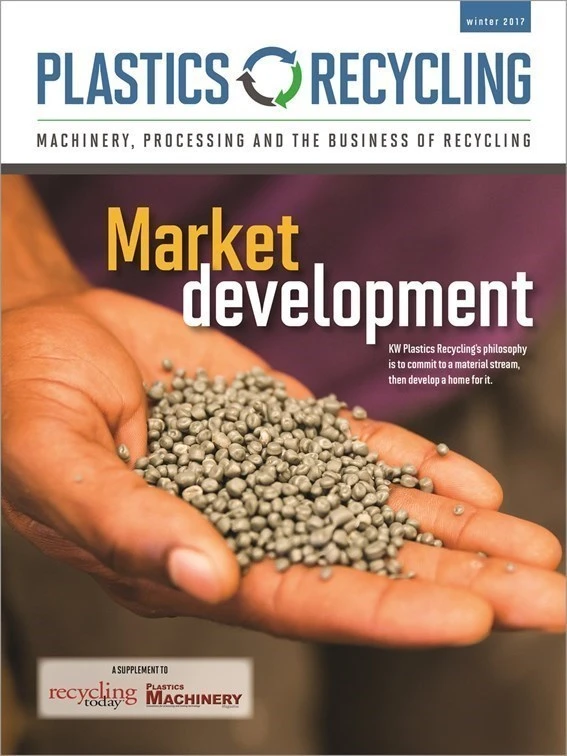
Tamsin Ettefagh, vice president of Reidsville, North Carolina-based Envision Plastics, began her career in plastics recycling as a community volunteer. Ettefagh, who has a degree in communications from Texas A&M, likely had no idea she would end up working in the plastics recycling sector when she began writing a newsletter for her Lochwood Park neighborhood in Dallas, which led her to start a volunteer curbside recycling program to earn money for a new neighborhood playground.
The rest, as they say, is history.
Ettefagh now helps to lead Envision Plastics, a producer and supplier of postconsumer recycled high-density polyethylene (HDPE) to the food, beverage, personal care, consumer health care and general industries. The company, founded in 2001, also offers toll processing, custom design services and recycled plastic packaging consulting.
While Ettefagh says opportunities exist for the industry, challenges are apparent, from the anticipated rise in virgin production capacity to the volume of postconsumer plastics being landfilled. She shares more of her views in the following Q&A.
What are your roots in the plastics recycling industry? I was first introduced to plastics recycling in early 1986; it was a grassroots beginning. I started a small volunteer curbside recycling program in a Dallas neighborhood and became very frustrated with plastics because they were confusing to differentiate and nearly impossible to get processed. I did a lot of research to find markets and worked on getting municipalities to add plastics to their collections. Then, I worked for one of the early plastics recycling plants, Phillips Recycling, and started my own company, Gulf National Trading. This led to an offer to join KW Plastics as the sales and purchasing manager, later becoming one of the equity owners at Envision Plastics prior to its sale to Consolidated Container Co. (in June 2014).
Where do you see opportunities and challenges for plastics recycling? Huge opportunities exist, both for film and rigid recycling, but nearly 70 percent of PET and HDPE bottles end up in landfills. The industry also faces a real challenge from the expected growth in virgin capacity. This will continue to pressure postconsumer suppliers to differentiate from virgin resin.
What misconceptions about plastics recycling do you wish you could debunk? That postconsumer material performs worse than virgin material. While our material performs differently, one of its greatest features is it has already been used! And is going to be used again! Postconsumer material has also demonstrated it can perform the same as virgin resin.
What’s the biggest professional mistake you have made? To think that it would be easy and economical. You have to really know this industry to be successful at it. It has not been easy.
What advice can you offer to younger plastics recyclers entering the market? Think outside the box, do not count on one market to sustain you and never, ever burn a bridge; you may very well need that supplier or customer again as market conditions change.
What lessons have you learned about the industry that have helped you throughout the years? The industry is full of very diverse and intelligent people who I take pride in being associated with. Honestly, the lessons are too numerous to name. I only hope that someday someone can say I contributed.
Have equipment manufacturers moved fast enough developing new technology to support recycling? Yes. However, opportunities exist for innovative technologies to further improve this industry.
What roles have you held over the years and in what ways have you contributed to the industry? Besides the aforementioned jobs, I have been involved in the National Recycling Coalition; CEED (Coalition for Earth’s Environment in Dallas); Texas Recycling Coalition; SERDC (Southeast Recycling Development Council); America Recycles Day, which I helped establish in Troy, Alabama; and was on the board of APR (The Association of Plastic Recyclers, at that time known as the Association of Postconsumer Plastic Recyclers) from 1998-2013.Who has served as your role model or mentor? My mother, an artist who worked hard at painting every single day, inspired my work ethic. All professions like hers, that make a living independently like she did, are role models for me. If they do not put in the hours, they do not earn a living.
David Cornell, who used to be the technical director of the APR, is another role model. Although he is now retired, for more than 20 years he has and continues to answer every question I have.
How has plastics recycling change over the years? In the beginning, it was about getting specifications created for bottles and cooperation among the CPGs (consumer packaged goods companies) to help with PET (polyethylene terephthalate) for bottle bills, making them practical in recycling. We also focused on growing the supply of HDPE and PET. The evolution continues, as some current initiatives are striving to create specifications for rigid container and film recycling, as well as working to better understand potential end markets for these materials.
How are industry trade groups doing an effective job in promoting the recycling industry? They have been very crucial in the effort to promote recycling. More collaboration between organizations could further improve their effectiveness. For instance, SPC (Sustainable Packaging Coalition) and APR are cooperating on the How2Recycle Label and the “Design Guidelines,” and we are seeing major retail chains, such as Wal-Mart and Target, use this tool to make packaging recyclable.
Get curated news on YOUR industry.
Enter your email to receive our newsletters.

Explore the February 2017 Plastics Recycling Issue
Check out more from this issue and find your next story to read.
Latest from Recycling Today
- Toppoint Holdings expands chassis fleet
- Lego creates miniature tire recycling market
- Lux Research webinar examines chemical recycling timetables
- Plastics producer tracks pulse of wire recycling market
- Republic Services, Blue Polymers open Indianapolis recycling complex
- Altilium produces EV battery cells using recycled materials
- Brightmark enters subsidiaries of Indiana recycling facility into Chapter 11
- Freepoint Eco-Systems receives $50M loan for plastics recycling facility






